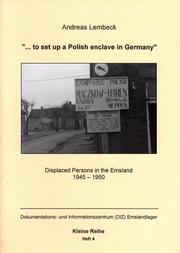Check nearby libraries
Buy this book

At the end of World War II, there were more than seven million men and women living in Germany who had been deported to the German Reich as slave labourers or prisoners of war. The Allies used the term "Displaced Persons" (DPs) to describe people who, because of the war, were not resident in their own country and wanted to return or to find a new home but could not do so without help. Almost six million DPs were repatriated in the five months from May to September 1945. The vast majority of those who went home came from the Western European countries and the Soviet Union. This Allied policy neglected other large national groups, especially Polish and Baltic DPs. During the period from June to September 1945 only 75,000 Poles had been repatriated from the Western zones of Germany. Some 800,000 remained in Allied-occupied territory and refused repatriation in the autumn of 1945.
On May 19th 1945, the 2nd Canadian Army decided to set up a Polish colony in the Emsland. The new national enclave was to be controlled by the 1st Polish Armoured Division. In June General Montgomery, the British Commander-in-Chief, gave his permission to continue with the project of evacuating the German population in order to create a Polish enclave. Within the context of this operation the British military government brought Polish DPs from other camps in the British zone to the Emsland region.
The plan to set up a Polish enclave was cancelled in mid-June 1945. By then, seven German villages had already been evacuated, so that the thousands of Polish DPs were able to settle in the Emsland. This development plus the fact that the 1st Polish Armoured Division had taken up occupation duties in May 1945 exerted a magnetic appeal to thousands of Polish DPs and former prisoners of war from the outside. At the end of 1945 the proportion of foreigners accommodated in former concentration camps, POW camps and in requisitioned houses in the Emsland region was between 10 (Lingen district) and 28 percent (Aschendorf-Hümmling district). For the DPs the Emsland served as a transit and the DP camps became waiting rooms. The United Nations Relief and Rehabilitation Administration (UNRRA) took care of these people, as did the soldiers of the Polish Division helping their countrymen.
By January 1946 the British military government had set up 15 Polish DP camps, five ex-prisoner of war camps and one DP-camp for Baltic nationals in the Emsland region. Maczków, the former German town of Haren (Ems), was the most renowned with a population of around 3.500
Check nearby libraries
Buy this book

Subjects
Refugees, History, Refugee camps, Poles, World War, 1939-1945, Polish peoplePlaces
Germany, Emsland, Emsland (Germany)Times
20th century| Edition | Availability |
|---|---|
|
1
"--to set up a Polish enclave in Germany": displaced persons in the Emsland 1945-1950
2001, Dokumentations- und Informationszentrum Emslandlager
in English
3926277092 9783926277091
|
aaaa
Libraries near you:
WorldCat
|
Book Details
Edition Notes
With photos and facsimiles. Includes bibliographical references.
Classifications
The Physical Object
ID Numbers
Community Reviews (0)
Feedback?| December 5, 2020 | Edited by MARC Bot | import existing book |
| April 28, 2010 | Edited by Open Library Bot | Linked existing covers to the work. |
| February 3, 2010 | Edited by WorkBot | add more information to works |
| December 9, 2009 | Created by WorkBot | add works page |









